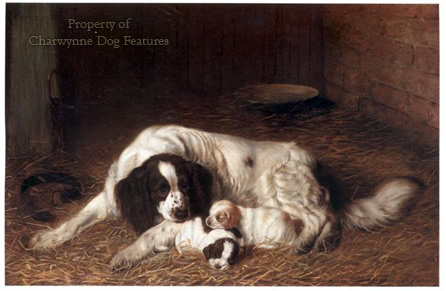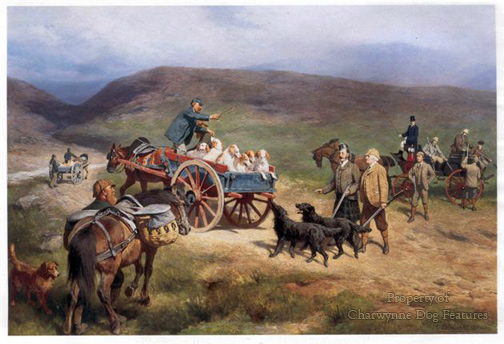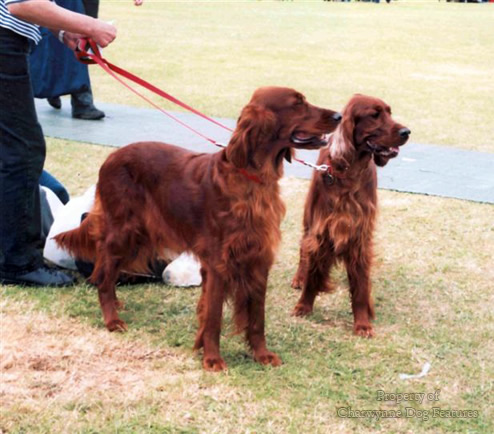600 Type in Setters
SETTING THE TYPE
by David Hancock
'A collie for the shepherd
And the cowman in his byre
But, over all the common curs,
A setter for the squire.'

Those words immediately convey the status of the setters in the past world of dog-fancying. For sheer style the setter and the Pointer have few rivals in the sporting dog world. But what is style without substance? we are regularly asked. What is the value of a stylish dog if its flashiness isn't supported by soundness? A year ago I was appalled by the Irish Setters at a dog show I visited; the lack of substance was certainly obvious there. We have now developed a show fashion in setters: long flowing hairy tails, over-furnished leggings, shaved necks and prominent occiputs. On the move we have the floaters, the dogs which prance rather than stride, which look so much more than they are. This show type sadly looks likely to become the future type in our setter breeds, as so many working lines fade away and the HPRs come more and more into the frame.
Even the show judges actually note many of the worst faults so proudly (and surprisingly ignorantly) entered for their assessment. Here are some judges's comments: Crufts, 2007, English Setters - 'Many have poor feet, often flat and splayed...shoulders remain a problem.' Crufts, 2006, Gordon Setters - 'I still find movement leaves much to be desired.' Irish Red and White Setters - 'Pinning was evident, also lack of strength in rearquarters.' The Kennel Club claims that this entry represents 'the best of the very best' in their show propaganda; what are the worst like! These dogs get bred from, some rather too much. Why should sportsmen care? Because some of finest sporting breeds of dog are being increasingly deconstructed and they are part of our national sporting heritage.
So many of our setter breeds display upright shoulders, short upper arms, snipey heads, poor feet and weak hindquarters, and these were breeds bred to work. Of course, adverse comments on dogs in the ring are not new: in 1893, an Irish Setter judge was noting on a Birmingham winner - 'There is no type about him; he is coarse in head, his quarters are weak, and his feet are bad.' But haven't we had a century or so to put this right? Show winners get bred from, tyro-sportsmen often buy show stock. Breeds, even famous sporting ones, can get slowly but surely undermined, altered to show needs, not tested in the field, not bred to a working design anymore. Do we just watch this happen? It is not entirely unconnected to note that terrier breeds like the Skye, the Dandie Dinmont and the Sealyham are gradually disappearing, whilst working terriers like the Plummer, the Fell and the Sporting Lucas gain ground.
It could be that the Scandinavians have better English Setters than us, the French have better Gordons and the Canadians better Irish Setters than we do. That, if true, is surely shameful. I believe that Irish setters make up around 12% of the entry in the field trial for them and Pointers yet win far more than 12% of the prizes, but as stalwarts like Marjory Jarosz and Auriel Mason retire will the impetus remain? A distinguished Labrador breeder David Coode recently wrote bemoaning the failure of the KC to ensure that judges in the gundog group have a knowledge of the working side of their breed. The KC has downgraded the gundog working gundog certificate to allow it to be taken on dummies rather than freshly shot game. Will this ensure they are 'fit for function' David queries.
Bob Truman, whose white Gordon once earned the tag of best grouse dog this century, also wrote to the dog press about the need for show judges to attend field trials. He went on to state that 'there were something like a mere eight working Gordon setter whelps produced last year and not all that many more English and Irish Setters. The Irish Red and Whites get their work blood (what there is of it!) from Ireland but it is woefully weak.' Margaret Sierakowski of the Dalriach Irish Red and white Setters commented on this: 'There were no litters of working IRWS bred in mainland UK in 2007...two litters of working IRWS are expected in the UK for 2008...but so far, all bookings for pups are from overseas...not a single inquiry about puppies from the UK.' This is not good news.
 There is something very special about a working setter, their sheer style is captivating and so pleasing to a sportsman's eye. We lose a great deal when we lose working setters. We could be left with setters with lots of canine 'bling' but not so much gundog function. In his Champion Dogs of the World of 1967, Sir Richard Glyn wrote: 'If one had to pick a dog, not a foxhound, as typical of English country life and the English country gentleman who lived it in the nineteenth century, then that dog would be the English Setter'. I do hope that in the twenty first century our memory of the working English Setter and indeed all the setter breeds isn't a fading one. Certainly as far as the working type is concerned, there are worrying signs that we are losing the essential functional physique. Sporting styles do change in each century, but it would be sad indeed if our concept of a setter was only that of a flashy over-furnished show-pony, fit only for ornamental duties.
There is something very special about a working setter, their sheer style is captivating and so pleasing to a sportsman's eye. We lose a great deal when we lose working setters. We could be left with setters with lots of canine 'bling' but not so much gundog function. In his Champion Dogs of the World of 1967, Sir Richard Glyn wrote: 'If one had to pick a dog, not a foxhound, as typical of English country life and the English country gentleman who lived it in the nineteenth century, then that dog would be the English Setter'. I do hope that in the twenty first century our memory of the working English Setter and indeed all the setter breeds isn't a fading one. Certainly as far as the working type is concerned, there are worrying signs that we are losing the essential functional physique. Sporting styles do change in each century, but it would be sad indeed if our concept of a setter was only that of a flashy over-furnished show-pony, fit only for ornamental duties.
We are disturbing the deserved rest of great setter men from the past: Laverack, Llewellin and Humphrey, to name but three. Writing in 1872, Edward Laverack, expressed his worry about the setter's degeneration, writing that 'This degeneration has been partly caused by the carelessness of the modern sportsman.' It is careless of today's sportsmen to leave a breed to the mercy of the show ring; it is careless to allow gundog judges to be appointed without attending field trials and it is simply reckless to allow working lines to be wholly exported. Isn't it about time that gundogs had an organisation of their own to further the best interests of working dogs? Gundog breeds are deservedly popular but bred to the wrong template by unenlightened breeders and rewarded by unenlightened judges, where are our precious gundog breeds heading?